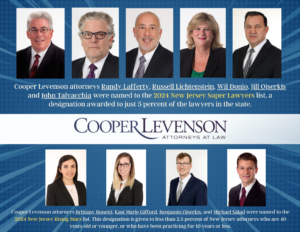By Carmelo T. Torraca and Elizabeth A. Kaufman
On September 14, 2017, in The Palisades at Fort Lee Condo Ass’n v. 100 Old Palisade, LLC, 2017 N.J. Lexis 845, the Supreme Court of New Jersey reversed and remanded to the trial court the Appellate Divisions decision in Palisades at Fort Lee Condo Ass’n v. 100 Old Palisade, LLC, 2016 N.J. Super. Unpub. LEXIS 193, wherein the Appellate Court was faced with an appeal from a Condominium Association which lost its cause of action against various contractors who created the defects in the building prior to the Condominium Association’s formation due to expiration of the six-year Statute of Limitations.
In the 2017 decision, the Court reversed and remanded the case because it was unclear as to exactly when notice of the six year Statute of Limitations for the construction defects began to accrue. The high Court held that “neither the trial court nor the Appellate Division applied the correct legal standard for determining when the construction-defect actions accrued pursuant to N.J.S.A. 2A:14-1. Although N.J.S.A. 2A:14-1’s six year statute of limitations typically commences upon substantial completion of a structure, the discovery rule applies to the accrual of a claim under N.J.S.A. 2A:14-1. Under that rule, the limitations clock does not commence until a plaintiff is able to discover, through the exercise of reasonable diligence, the facts that form the basis for an actionable claim against an identifiable defendant.” Palisades(2017) at 11 citing Caravaggio v. D’Agostino, 166 N.J. 237, 246(2001). However, the word “accrual” is not defined within N.J.S.A. 2A:14-1.
The Supreme Court held,
“ the date that a structure is deemed substantially complete oftentimes is when a cause of action accrues because some construction defects will be readily apparent on inspection and therefore the plaintiff will have a reasonable basis for filing a claim. But many construction defects will not be obvious immediately. In such instances, a cause of action does not accrue until the plaintiff knows or, through the exercise of reasonable diligence, should know of a cause of action against and identifiable defendant. A plaintiff who is a successor in ownership takes the property with no greater rights than an earlier owner. If the earlier owner knew or should have known of a cause of action against an identifiable defendant, the accrual clock starts then.”
By way of history, this 11-story parking structure and 30-story residential tower was purchased in 1998. Defendant contractors then began work improving the residential tower. Afterwards, the property operated as a rental property for approximately two years. On June 28, 2004, the property was sold to 100 Old Palisade, LLC, which began the process of converting the property into a condominium form of ownership pursuant to the New Jersey Condominium Act, N.J.S.A. 46:8B-1, et. seq.
In January 2005, Old Palisade issued a Public Offering which included an engineering report prepared by Ray Engineering, Inc. A Master Deed was created, in accordance with the condominium rules, providing that the Association, through its board members, was responsible for the maintenance and repair of the common areas of the property as defined by the Master Deed. Old Palisade retained control of the Board until members were chosen by unit owners. Upon the sale of 75% of the units, full control of the Board was transferred to the unit owners.
In July 2006, following the sale of the required number of units, the unit owners gained full control of the Association’s Board. The Association then retained Falcon Engineering Group to undertake an engineering evaluation of the property. In May 2007, Falcon produced a report which identified various construction defects in the property, including defects in the exterior wall, parking garage, roof, and plaza terraces. Falcon provided the report to the Association Board on June 13, 2007.
Plaintiff filed its first of eight Amended Complaints on March 12, 2009, asserting claims against various parties, including the persons and entities involved in the conversion of the property to condominium ownership. Plaintiff also asserted construction defect claims against various contractors who performed work on the property before its conversion.
The parties all agreed that the substantial completion date of the contract for the work was May 1, 2002, well beyond the six-year statute of limitations as required by N.J.S.A. 2A:14-1 for a Complaint filed in 2009. The Trial Court, relying upon the substantial completion date, found that the Complaint was filed untimely and granted the summary judgment in favor of the Construction Defect Defendants. The Judge wrote that the Defendant Contractors could not have reasonably anticipated that the Association would eventually be formed and they would be “forever liable” for the alleged construction defects, notwithstanding the six-year statute of limitations.
The Appellate Court decided this solely upon a legal issue, therefore it owed no deference to the Trial Court’s “interpretation of the law that flows from the established facts.” The Court cited to N.J.S.A. 2A:14-1 which, in pertinent part, provides that claims for tortious injury to real property or for a recovery under a contract claim “shall be commenced within [six] years after the cause of action shall have accrued.” The statute does not define when a cause of action accrues and that issue has “been left entirely to the judicial interpretation and administration.”[1]
The Appellate Court began its analysis the same as the lower Court by observing that the statute of limitations on an action for deficiencies in design or construction commences to run upon substantial completion of the structure.[2] However, the date of accrual may be delayed by application of a discovery rule or other equitable considerations.[3] In effect, the date the limitation began to run is when the Plaintiff knew or should have known of the defect. The Court could have easily relied upon the Falcon 2007 report to initiate this accrual period indicating that the more specific report identifying the defects served as Plaintiff’s discovery of damages. However, the Court was faced with the difficulty that the Ray Engineering report also identified, albeit not to the same specificity, some of these defects. Instead, the Court placed significant weight upon the formation of the Association.
The Court cited to the Condominium Law stating that the Association has the responsibility for “maintenance, repair, replacement, cleaning and sanitation of the common elements” of the condominium. The Court also acknowledges that an individual unit owner can file a derivative action on behalf of the Association against the contracting defendants for construction defects in the common elements; however, the unit owners were not compelled to do so.
Indeed, it would be unreasonable for the statute of limitations to run on the claim of a condominium association, unless a unit owner, or group of unit owners, took on that responsibility. We are convinced that, under the circumstances, the statute of limitations could not begin [to] run on the Association’s claims until the unit owners had full control of the governing Board.
This definition of accrual based upon the formation of the party who initiated the claim is a new concept and not previously cited by other case law. The Court’s reliance upon both the formation of the Association, which was in 2005, and the 2007 Falcon report was a basis for overturning the Trial Court’s granting of the summary judgment.
The Court also went on to disagree with the Trial Court’s assertion that it would be unfair to allow the Association to assert its claim against Defendant contractors because Defendants could not have reasonably anticipated that the property would have been converted to a condominium, that the Association would eventually be formed, and that they would be “forever liable” for the alleged construction defects. The Appellate Court relied upon N.J.S.A. 2A:14-1.1(a), providing for a Statute of Repose of ten years terminating all construction defect claims irrespective of the conditions. This ten-year limitation for the Statute of Repose “generally commences one day after the issuance of the Certificate of Substantial Completion for the project.” The purpose of the Statute of Repose was to limit the expanding liability of contractors, including an expansive application of the discovery rule.
Fortunately, the Supreme Court disagreed. The Supreme Court rejected the concept of the Statute of Limitations beginning when the suing party, in this case the Association was created. Rather, the Supreme Court reaffirmed that the Statute of Limitations accrues when anyone in the ownership chain knew or reasonably should have known of a construction defect based upon “objective evidence.” A subsequent owner has no better standing in the Statute of Limitations analysis than any of the previous owners.
[1] Quoting, Russo Farms v. Vineland Bd. of Ed., 114 N.J. 84, 98 (1996).
[2] Mahony-Troast Constr. Co. v. Supermarkets Gen. Cor., 189 N.J. Super. 325, 329 (App. Div. 1983). See also, Russo Farms, supra, 144 N.J. at 115-116.
[3] Trinity Church v. Lawson-Bell, 394 N.J. Super. 159 (App. Div. 2007).








